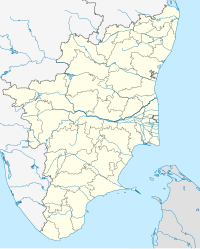Attur Fort
| Attur Fort | |
|---|---|
| Part ofTamil Nadu | |
| Attur,Tamil Nadu,India | |
 Attur Fort | |
| Coordinates | 11°36′13″N78°36′03″E/ 11.603529°N 78.600868°E |
| Type | Forts |
| Site information | |
| Controlled by | Department of Archaeology |
| Site history | |
| Built | 17th century |
| Built by | Gatti Mudaliars |
Attur Fortis a historic fort present inAtturinSalem districtin theSouth Indianstate ofTamil Nadu.The fort is located on the banks of river Vashista, 56 km (35 mi) away fromSalem.The fort was built by aPalaiyakkararchieftainGatti Mudaliar dynastyunderMadurai Nayaks,called Lakshmana Nayakan during the 17th century.
It was also occupied byHyder Ali,Tipu SultanandBritishduring various times. While it was Tipu Sultan, it switched hands to the British East India Company who got five forts including this one as a part of the Treaty of Srirangapatnam. The fort was used by the British as a garrison till 1854, after which the fort was not operational. In modern times, the fort is under the control of the Archaeological Department of theGovernment of Tamil Nadu.The fort houses two magazine points, two palaces, a court, three treasuries and three temples. Some portions of the fort are dilapidated, while most other portions are encroached on by slum dwellers.
History
[edit]The Fort was constructed by a localPalaiyakkararchieftainGatti Mudaliar dynastyunderMadurai Nayaks.[1]Attur fort became part ofMysore Kingdomin late 17th century when frequent wars betweenMysore KingdomandThirumalai NayakofMaduraiwhen large parts of north west Tamil region fromDindigulbecame part of Mysore rulers.[2]The region became part ofMysoreWodeyarrulers and later underHyder Aliof Mysore till 1768, when surrendered to Wood ofEast India Company.Hyder Ali regained the town from theBritish East India Company,but the Company won a decisive victory in the 3rd Mysore war was againstTipu Sultan,the son of Hyder Ali.[3]Tipu Sultanwent on utilize the fort as an arms depot and watch tower. It switched hands to the British East India Company who got five forts including this one as a part of the Treaty of Srirangapatnam.[4]
After the Third Mysore War the region became part ofMadras PresidencyunderBritish.The fort was used by the British as a garrison from 1792 by the 23rd Madras battalion under the command of Captain Campbell. During subsequent years, the fort was used as an ordnance station from 1799 as the Company troops moved to Sankagiri. After 1854, the fort ceased to act as an operational fortress and the region was clubbed into the newly formedSalem Districtunder theMadras Presidency.[2]
In modern times, the fort is under the control of the Archaeological Department of theGovernment of Tamil Nadu.[5]Some portions of the fort are dilapidated, while most other portions are encroached on by slum dwellers.[6][7][8]In modern times, the fort is maintained by theArchaeological Survey of India.[9]
Architecture
[edit]
Atturtown is situated on the southern bank of the Vasista river. The town was called Attur Ananthagiri during the Mysore rule in 1689 and was called Attur by end of the 18th century. Attur is located 56 km (35 mi) away fromSalem.The four has four entrances on all four directions.[10]
The fort occupies an area of 62 acres (250,000 m2) The walls of the fort are about 30 ft (9.1 m) tall and 15 ft (4.6 m) wide. It is decorated by wedge shaped cut-stones fitted without mortar. The construction material for the walls are believed to be quarried from the Kalladithankundru. The fort was guarded by the river in the east and by moats on other sides. The Gatt dynasty used the large chamber inside the fort as audience hall during their regime. The pool house, used for the pleasure of the royal family, was fed from the river through a water gate.[6][11]The trenches in the fort are constructed in such a way that the water from the river fills it from the South side and joins the course downstream. The fort houses two magazine points, two palaces, a court, three treasuries and three temples. The fort also houses the image of a soldier riding a horse, the tombs of Lieutenant Colonel John Murray and Henry Coyle, Attur Fort Captain, are located on the back side of the fort.[10]
References
[edit]- ^B. S. Baligayear. (1967).Madras District Gazetteers: Salem.Superintendent, Government Press. p. 74.ISBN9785519483643.
- ^abVink, Markus (2015).Encounters on the Opposite Coast: The Dutch East India Company and the Nayaka State of Madurai in the Seventeenth Century.BRIL. p. 483.ISBN9789004272620.
- ^N.S., Ramaswami (1984).Political History of Carnatic Under the Nawabs.Abhinav Publications. p. 207.ISBN9780836412628.
- ^S.P., Saravanan (23 January 2015)."Slice of history in shambles".The Hindu.Retrieved4 November2021.
- ^"List of forts in Chennai circle".Archaeological Survey of India, Chennai circle.Retrieved10 July2021.
- ^ab"Attur Historical moments".Attur Municipality.2011. Archived fromthe originalon 18 August 2013.Retrieved7 July2013.
- ^Great Trigonometrical Survey (1891).Synopsis of the Results of the Operations, Volume 25.Columbia University. p. 75.
- ^Fanu, Henry Le (1883).A manual of the Salem district in the presidency of Madras.Oxford University. p.53.
attur fort.
- ^"Alphabetical List of Monuments - Tamil Nadu".Archaeological Survey of India. 2011.Retrieved9 September2013.
- ^ab"A walk to soak in the heritage".The Hindu.17 October 2016.Retrieved10 July2021.
- ^"Historic fort".The Hindu.14 January 2012.Retrieved7 July2013.



